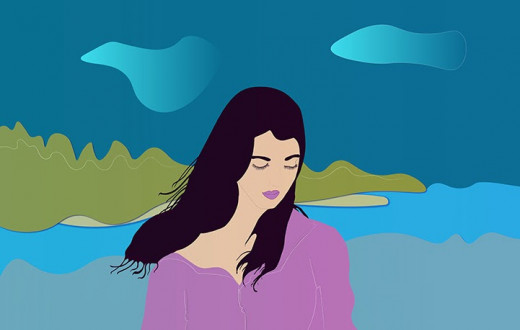By Sejal Shah
Whether you are a CEO, a diplomat, a student, or a homemaker, a regular breathwork practice can be a great addition to your daily routine. Find out how.
Our first act of life as we come out of our mother’s womb is to take a breath in. The last act of life as we depart from this planet is to breathe out. In between, we live only because we can breathe. And how we breathe determines the quality of our life, yes you read that right. Breathwork (or breath work) is fast becoming popular as it promises to offer immense benefits. Before we dive into the details, check out our infographic.

What is breathwork?
Breathwork refers to a type of breathing technique that involves an active form of conscious breathing to rise above the mind and enter a higher state of consciousness or awareness. Here you experience peace, calm, clarity, bliss, unconditional love, and healing at many different levels. This is what most people seek when meditating, and breathwork has the potential to take you to the meditative state very easily and quickly. From top-notch Silicon Valley CEOs to young professionals or entrepreneurs, to students and homemakers, to prisoners to war veterans, to healthcare professionals, people from all walks of life often practice breathwork to improve their physical, mental, emotional, social, professional, and spiritual well-being.
What is the purpose of breathwork?
Breathwork has its roots in ancient yogic teachings, that define the practice of directing the breath as pranayama, wherein you breathe consciously, with awareness, and in certain patterns of inhalation, exhalation, and retention of breath. In those days, the purpose of a pranayama practice was to uncover the inner light. They were a means to prepare for meditation. But today, breathwork has evolved to include many new breathing exercises that also focus on as a means of self-healing and therapy.
While various breathing practices (aka breathwork) have been around for centuries, science too is finally beginning to provide evidence that the benefits of these ancient practices are immense and real. Studies have found that breathing practices can help with general wellbeing, health, and happiness but can also help reduce symptoms associated with stress, anxiety, depression, insomnia, trauma (PTSD), attention deficit disorder, inflammation, low immunity, indigestion, and many more.
What are the different types of breathwork techniques?
There are many types of breathwork practices, ranging from fairly basic and easy to learn at home, to others requiring a practitioner to teach you the practice. Deep breathing is one of the simplest forms of breathwork. At the physiological level, some are hyperventilation types, some hypoventilation. Some tend to induce respiratory alkalosis. Some like the SKY technique act by stimulating the Vagus nerve. Each one has a different purpose, effect, and benefit. Some breathwork practices are rooted in the eastern yogic traditions of pranayama while some other breathwork practices like Holotropic, Rebirthing(Clarity), Wim Hof, Shamanic, Box breathing, Straw breathing, were developed in The West too.
Here are a few Pranayama or eastern-based popular breathwork practices:
Basic: Though best to learn with a qualified teacher, these can be learned from home on your own too. Learning from teachers assures you that you are doing them right.
Nadi Shodhan (Alternate nostril breathing): Read more here or watch this video.
Kapalbhati (Skull-shining breath): Read more here.
Bhastrika (Bellows breath): Read more here.
Bhramari (Bee breathing): Read more here.
Advanced: These are best learned with teachers, as these tend to become intense. Once you learn from a trained teacher, you can practice on your own at home.
Kriya yoga
Sudarshan Kriya (SKY Breath Meditation)
What does a basic breathwork session look like?
These sessions are short, maybe 5-10 minutes long. Many yoga studios teach these breathing practices during a yoga class. They are pretty easy to learn. With most of these, you will feel either calm, energetic, or both. Yet all of them offer other specific effects and benefits.
What does an advanced breathwork session such as SKY look like?
Most formal teaching sessions of SKY involve three sessions of theoretical explanation and 20-30 minutes of gentle, rhythmic, circular breathing with a well-trained teacher. As you're breathing, your teacher will guide you through the journey. You may follow their guided instructions and counts, and be with your own unique experience. Be relaxed, open, and trust that the breath will take you to where you need to go for the deepest level of healing available to you at that time.
Some thoughts, feelings, sensations, visions, or fragrances might come up during a breathwork session. People who practice breathwork describe feeling tingling sensations throughout their body, some tightness, feelings of clarity, alertness, increased mind-body connection, and even emotional release. No matter what is happening, you keep breathing and know that what is happening is supposed to be happening. Your body-mind has an innate intelligence and wisdom and it will support you in releasing some deep-rooted stresses and impressions that no longer serve you. Just be at ease and trust that process.
Besides the breathwork practice, the sessions also include some gentle yoga, some fun games, and some spiritual cognitive-behavioral tips that help to refine and strengthen our approach to life and relationships. The teacher will also teach you some pranayama and a 10-min home SKY practice that you can do on an everyday basis.
SKY teachers undergo extensive training before they could start teaching. They have sufficient knowledge and expertise to guide you through the whole process. Their presence makes you feel comfortable and relaxed. Most teachers are available to mentor you and guide you on your SKY journey on a long-term basis. There are well-established practice meetups led by the teachers.
What is Sudarshan Kriya or SKY Breath Meditation?
Our life is vast and infinite like the sky. ‘Su’ means proper or clear, ‘darshan’ means vision, ‘kriya’ means a purifying act of breathing. With the practice of Sudarshan Kriya, as you release toxins and destress, you get a clear vision of this vastness and infinite nature of your being.
SKY, a unique yogic breathing practice, involves several types of cyclical breathing patterns, ranging from slow and calming to rapid and stimulating. There is mounting evidence to suggest that SKY can be a beneficial, low-risk, low-cost adjunct to the treatment of stress, anxiety, post-traumatic stress disorder, depression, stress-related medical illnesses, substance abuse, and rehabilitation of criminal offenders. It is easy and safe breathwork that brings you to the doorway of meditation where you effortlessly slip into a meditative state. Though it is breathwork, it is so powerful that it almost feels like meditation. Hence it is recently being introduced as SKY Breath Meditation.
It was created by Gurudev Sri Sri Ravi Shankar, the founder of Art of Living Foundation, around 40 years ago when he went into complete silence for 10 days. As a gifted child with extraordinary abilities, plus a bachelor’s degree in quantum physics, a deep interest in spirituality, and a sincere inclination to serve the world, he started teaching SKY. Soon it became popular in India and many parts of the world. As of today, there are 35,000+ SKY teachers and millions of people across 156 countries have learned it and practice it regularly.
What are the benefits of SKY?
SKY practitioners report everything from deep relaxation and more mindfulness to reduced stress, anxiety, and depression. Here is an infographic presentation of the science-backed benefits of SKY.
Benefits of SKY Breath Meditation: Why is breathwork powerful?
On a day-to-day basis, SKY practitioners report calm, clarity, increased energy, freshness, better sleep in just a few days of practicing SKY. Following are some long-term benefits of the daily practice of SKY.
Physical health benefits of SKY
Reduces stress
Improves overall health and well-being
Boosts energy levels
Strengthens immune system
Reduces cholesterol levels
Healthier blood pressure
Reduced addictive behaviors
Improved respiratory function
Mental health benefits of SKY
Greater clarity of mind and mental focus
Enhanced deep sleep
Enhances brain function
Improves ability to manage challenging situations
Boosts creativity
Increased life satisfaction
Improved interpersonal relationships with SKY
More ease and harmony in personal and work relationships
A deeper sense of community
Increases awareness of self and surroundings
Improves patience
Increases confidence and self-esteem
Psychological benefits of SKY
Relieves depression (both clinical and non-clinical)
Reduces anxiety (both clinical and non-clinical)
Reduces PTSD with quick and long-term effects
Enhanced optimism
Increased self-esteem and joy
Spiritual benefits of SKY
Increases inner peace
Deeper connection with your inner self
Increases compassion
Broad vision
How can I learn SKY Breath Meditation (Sudarshan Kriya)
If you are new to breathwork and want to connect with a teacher to get started, you can find them on the Art of Living Journey App. You can download it for free either from the App Store or Google Play. Or you could also attend a free online introductory session, where an instructor can provide all necessary information along with an experience of basic breathwork and meditation, in addition to answering any questions that you may have.
Sejal Shah, E-RYT 500 Sri Sri Yoga Teacher, YACEP, C-IAYT, Meditation Teacher, SKY Instructor, NYU Post Graduate Medical School approved Yoga-CME retreat facilitator, Mind-Body Wellness Writer, Homeopath. She can be followed on YouTube, Instagram, Twitter, and Facebook.



























